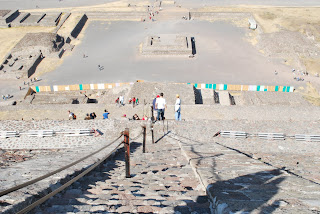Teotihuacan’s origins go back to several hundred years before the birth of Christ. At its peak, it covered 20 sq. km. (8 sq. miles) and had a population of 200,000 people and was composed of different cultures. Around 600 AD it began to decline. Later on, the Aztecs worshipped it.
I began at the Avenida de los Muertos (Avenue of the Dead), which begins at the Ciudadela (Citadel), and goes all the way to the Pyramid of the Moon. In ancient times it stretched much further. The ciudadela, built around 200 ADD, contains the Templo de Quetzalcoatl, which was only discovered in the 1920s.
Without a doubt the main attraction is La Piramide del Sol (Pyramid of the Sun). Its base is as wide as the pyramids in Egypt, but it’s only half as high. Nonetheless, visitors to Teotihuacan climb 250 uneven steps to enjoy the view at the top.
At the end of the Avenida de Los Muertos is La Piramide de La Luna (Pyramid of the Moon). Unfortunately, visitors can only climb the first set of stairs. The view of entire complex is still spectacular. Next to the Pyramid is the Quetzalpapalotl Palace Complex, which was discovered in 1962. Inside are murals of birds and jaguars.
 Japanese people flock to Teotihuacan.
Japanese people flock to Teotihuacan. A view from the top of La Piramide de La Luna. It was worth the climb.
A view from the top of La Piramide de La Luna. It was worth the climb.
A view from the Ciudadela of La Piramide de La Luna (foreground) and La Piramide del Sol (background).
No comments:
Post a Comment